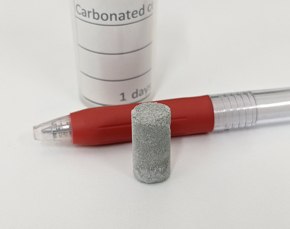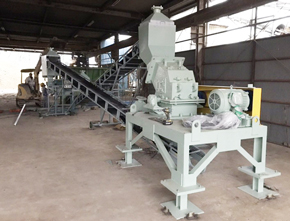Return to Construct Hokkaido(More articles in English here.)
New Method for Concrete Production – Under Development by Hokkaido University Researchers Using Waste Concrete and CO2
A project team of researchers from Hokkaido University and the University of Tokyo is developing technology for new concrete made from waste concrete and CO2. Utilizing a method with which waste concrete that has absorbed CO2 causes calcium carbonate deposition, the team aims to produce concrete with practical strength. Associate Professor Ryoma Kitagaki of the Division of Architecture, Faculty of Engineering, Hokkaido University, who plays a central role in the development of raw materials, says, “We want to develop a method that can produce raw materials using the equipment and technology of local companies.”
 |
| Hardened body produced by the developed technology (photo courtesy of the University of Tokyo) |
According to the project team, cement production emits approximately 5% of human-derived CO2. Accordingly, if this new technology is put into practical use, it will lead to carbon-neutral development in the construction industry.
Although calcium contained in concrete has the property of absorbing CO2 in the atmosphere, the range is only several centimeters from the surface. Concrete retaining a large amount of calcium that can absorb CO2 is discarded.
For recycling, crushed waste concrete is generally used for roadbed materials. In some cases, it is used as a raw material for recycled concrete. However, Associate Professor Kitagaki of the project team says, “It is rarely used in Hokkaido because it is vulnerable to freezing damage.” Since cement is newly added to recycled concrete, issues remain in terms of CO2 reduction.
The project team calls this material being studied calcium carbonate concrete (CCC) and started development in 2020. Their aim is to develop a carbon-neutral material that can absorb and immobilize up to the same amount of CO2 that waste concrete has emitted in the past. It is said that repeated recycling will also be possible.
 |
| Test plant for manufacturing CCC raw materials (photo courtesy of Masuo Recycle) |
The three studies of raw material development, manufacturing, and social implementation are moving forward in parallel. In raw material development, the team is searching for the optimum CO2 absorption efficiency by adjusting the particle size, surface area, and humidity of waste concrete. At the laboratory and the test plant of Masuo Recycle (headquarters: Tokyo), methods such as spraying hot air and water are being tried.
During the manufacturing phase, calcium carbonate is deposited by immersing the raw material that has absorbed CO2 in a calcium solution to fill the gaps and increase the strength. Professor Ippei Maruyama of the University of Tokyo and others are at the center of this research.
According to Associate Professor Kitagaki, “Approximately 70% of the practical strength has been achieved.” The goal going forward is to fulfill the practical strength by 2023 and construct a building using CCC by 2030.
According to the project team, if half of the concrete used in Japan is CCC in 2050, it will be possible to reduce CO2 emissions by 20 million tons per year and immobilize 6.2 million tons per year. Associate Professor Kitagaki emphasizes the significance saying, “If it can be put into practical use, the construction industry will be able to recover the majority of its own CO2 emissions.”
Approximately 50 years have passed since Japan’s period of high economic growth, and many concrete buildings are on the verge of being dismantled and rebuilt. The progress being made with this research is expected to result in a future in which waste contributes to CO2 reduction and can be reused as a construction material.
(Excerpt from an article on June 18, 2021)
メニュー

